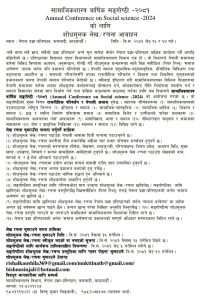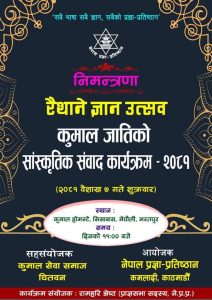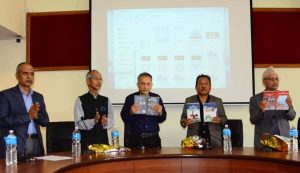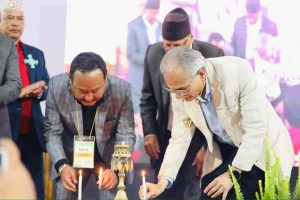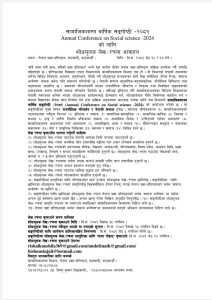नेपाल प्रज्ञा–प्रतिष्ठान नेपालका भाषा, साहित्य, दर्शनशास्त्र, संस्कृति तथा सामाजिक शास्त्रसम्बन्धी अध्ययन, अन्वेषण गर्न, मौलिक सिर्जनात्मक वातावरणको निर्माण गर्न, राष्ट्रका विद्वान एवं प्रतिभाहरुको सम्मान गर्न, सिर्जनात्मक चिन्तन र रचनात्मक कार्यमा जनताको सर्वाङ्गीण सहभागिता जुटाउन राष्ट्रिय एवं अन्तर्राष्ट्रिय स्तरमा प्राज्ञिक गतिविधिको सञ्चालन गर्न स्थापित एक राष्ट्रिय प्रतिष्ठित संस्था हो ।
यस प्रतिष्ठानको स्थापना तत्कालीन नेपाल सरकारबाट ‘नेपाल एकेडेमी ऐन २०१४’ पारित गरी सोही ऐनअनुसार नेपाली साहित्य, कला एकेडेमीको नाममा भएको थियो । वि.सं. २०१४ मा गठित यो प्रतिष्ठान २०३१ मा पुनः अर्काे ऐनद्वारा नेपाल राजकीय प्रज्ञा–प्रतिष्ठानमा परिणत भयो । नेपालमा गणतन्त्रको स्थापना भएपछि साविक राजकीय प्रज्ञा–प्रतिष्ठानमा रहेका ललितकला र सङ्गीत, नाट्य विधाका निम्ति अलग्गै प्रज्ञा–प्रतिष्ठानको गठन गर्ने व्यवस्था निम्न विधामा प्राज्ञिक कार्य गर्ने उत्तरदायित्वका साथ नेपाल प्रज्ञा–प्रतिष्ठान ऐन २०६४ द्वारा सङ्गठित नेपाल प्रज्ञा–प्रतिष्ठान हाल क्रियाशील रहेको छ।
नयाँ प्रावधानअनुसार नेपाल प्रज्ञा–प्रतिष्ठानमा निम्नलिखित प्रमुख पाँच विषय क्षेत्र रहेका छन्ः
१. भाषा
२. साहित्य
३. संस्कृति
४. सामाजिक शास्त्र
५. दर्शनशास्त्र
उद्देश्य
नेपाल प्रज्ञा–प्रतिष्ठानका मूल उद्देश्यहरू यस प्रकार छन्ः
- नेपाली भाषा लगायत नेपालका अन्य भाषाहरू, तिनमा लेखिएका साहित्य, संस्कृति, सामाजिक शास्त्र एवम् दर्शनशास्त्रसम्बन्धी विभिन्न विषयको अध्ययन, अनुसन्धान र अन्वेषण गर्ने, गराउने ।
- मौलिक सिर्जनाका माध्यमद्वारा ती विषयमा उपयोगी कृतिहरू तयार गर्ने, गराउने ।
- यस क्षेत्रका विद्वान् एवम् प्रतिभाहरूको समुचित कदर एवम् सम्मान गर्ने ।
- उपर्युक्त विषयमा अन्य राष्ट्रिय एवम् अन्तर्राष्ट्रिय संस्थासँग सम्बन्ध विस्तार गर्ने ।
- अन्तर्राष्ट्रिय स्तरमा सिर्जनात्मक चिन्तन र रचनात्मक कार्यमा जनताको सहभागिता र अभिरुचि बढाई बौद्धिक तथा सांस्कृतिक क्षेत्रको सर्वाङ्गीण विकास गर्ने ।
योजना र कार्यक्रम
माथिका उद्देश्यहरू पूरा गर्न नेपाल प्रज्ञा–प्रतिष्ठानले प्रमुख रूपमा निम्नबमोजिमका कार्यक्रमहरू सञ्चालन गर्ने छः
- नेपालका भाषा, साहित्य, संस्कृति, सामाजिक शास्त्र र दर्शनशास्त्रसम्बन्धी विभिन्न विषयमा अनुसन्धानात्मक तथा मौलिक कृतिहरूको सिर्जना गर्ने, गराउने ।
- नेपाली र नेपालका अन्य भाषाहरूमा विदेशी भाषाका उच्चस्तरीय कृतिहरूको अनुवाद गर्ने, गराउने तथा नेपाली र नेपालका अन्य भाषाहरूका उच्चस्तरीय कृतिहरूको विदेशी भाषाहरूमा तथा नेपालकै विभिन्न भाषामा अन्तरभाषिक अनुवाद गर्ने, गराउने ।
- भाषा, साहित्य, संस्कृति, सामाजिक शास्त्र र दर्शनशास्त्रका विभिन्न विषयमा राष्ट्रिय र अन्तर्राष्ट्रिय स्तरका प्रवचन, गोष्ठी, विचार–विमर्श, सम्मेलन, प्रदर्शनी आदि गर्ने, गराउने ।
- प्रज्ञा–प्रतिष्ठान र सम्बद्ध अन्तर्राष्ट्रिय सङ्घ–संस्थासँग सम्बन्ध राख्ने र तिनसँग मिली सांस्कृतिक एवम् प्राज्ञिक गतिविधि आदानप्रदान गर्ने ।
- भाषा, साहित्य, संस्कृति, सामाजिक शास्त्र र दर्शनशास्त्रका विभिन्न विषयमा उल्लेखनीय योगदान दिने स्वदेशी तथा विदेशी विद्वान्, साहित्यकार एवम् कलाकारहरूको कदर तथा सम्मान गर्ने ।
- सम्बद्ध विषयका विद्वान्, साहित्यकार र विशेषज्ञहरूको प्रतिभा विकसित हुने वातावरणको सिर्जना गर्ने ।
- विशिष्ट विद्वान् तथा साधकहरूलाई मानार्थ तथा आजीवन सदस्यता प्रदान गर्ने ।
नेपाल प्रज्ञा–प्रतिष्ठानको सङ्गठन
नेपाल प्रज्ञा–प्रतिष्ठानको सङ्गठन देहायबमोजिम छः
- प्राज्ञसभा
- प्राज्ञपरिषद्
- सेवा आयोग
प्राज्ञसभा
प्राज्ञसभा प्रज्ञा–प्रतिष्ठानको सर्वोच्च निकाय हो । यसको मुख्य कार्य प्राज्ञ–परिषद्लाई मार्गदर्शन गर्नु, निर्देशन दिनु, वार्षिक नीति, योजना तथा कार्यक्रम स्वीकृत गर्नु, विद्वद्वृत्ति, सम्मान, प्रज्ञा मानार्थ–सदस्यता तथा आजीवन–सदस्यता प्रदान गर्नु, उपयुक्त व्यक्ति वा संस्थालाई कदर, सम्मान वा पुरस्कारको व्यवस्था गर्नु तथा आवश्यक नियम बनाउनु हो ।
प्राज्ञसभाको गठन देहायबमोजिम हुन्छ
(क) कुलपति अध्यक्ष
(ख) उपकुलपति उपाध्यक्ष
(ग) सचिव, संस्कृति मन्त्रालय पदेन सदस्य
(घ) कुलपति, उपकुलपति र सदस्य सचिव सहित नेपाली तथा नेपालका अन्य राष्ट्रभाषाहरू तथा तिनको साहित्य, संस्कृति, सामाजिक शास्त्र र दर्शनशास्त्रसम्बन्धी विभिन्न विषयमा उल्लेखनीय योगदान पु¥याएका व्यक्तिहरूमध्येबाट प्रधानमन्त्रीद्वारा मनोनीत पैंँतिस जना सदस्य
(ङ) प्रज्ञा–प्रतिष्ठानका सचिव सदस्य सचिव
प्रधानमन्त्री प्रज्ञा–प्रतिष्ठानको प्रमुख संरक्षक र संस्कृति मन्त्री संरक्षक हुनुहुन्छ ।



